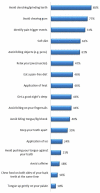The feasibility of a clinical trial of pain related to temporomandibular muscle and joint disorders: the results of a survey from the Collaboration on Networked Dental and Oral Research dental practice-based research networks
- PMID: 23283934
- PMCID: PMC3539212
- DOI: 10.14219/jada.archive.2013.0022
The feasibility of a clinical trial of pain related to temporomandibular muscle and joint disorders: the results of a survey from the Collaboration on Networked Dental and Oral Research dental practice-based research networks
Abstract
Background: The authors conducted a survey to characterize the strategies used by general dentists to manage pain related to temporomandibular muscle and joint disorders (TMJDs) and to assess the feasibility of conducting a randomized controlled trial (RCT) to determine the effectiveness of these strategies.
Methods: Dentists from three dental practice-based research networks (PBRNs) (The Dental Practice-Based Research Network, Practitioners Engaged in Applied Research and Learning Network and Northwest Practice-based REsearch Collaborative in Evidence-based DENTistry) agreed to participate in this survey.
Results: Of 862 dentists surveyed, 654 were general dentists who treated TMJDs; among these, 80.3 percent stated they would participate in a future RCT. Dentists treated an average of three patients with TMJD-related pain per month. Splints or mouthguards (97.6 percent), self-care (85.9 percent) and over-the-counter or prescribed medications (84.6 percent) were the treatments most frequently used. The treatments dentists preferred to compare in an RCT were splint or mouthguard therapy (35.8 percent), self-care (27.4 percent) and medication (17.0 percent).
Conclusions: Most general dentists treat TMJD-related pain, and initial reversible care typically is provided. It is feasible to conduct an RCT in a dental PBRN to assess the effectiveness of splint or mouthguard therapy, self-care or medication for the initial management of painful TMJD.
Clinical implications: There is an opportunity to do an RCT in a dental PBRN, which could lead to the development of evidence-based treatment guidelines for the initial treatment of TMJD-related pain by primary care dentists.
Figures




Similar articles
-
Temporomandibular disorders in children and adolescents: a survey of dentists' attitudes, routine and experience.Swed Dent J. 2001;25(3):119-27. Swed Dent J. 2001. PMID: 11813448
-
Dental splint prescription patterns: a survey.J Am Dent Assoc. 1995 Feb;126(2):248-54. doi: 10.14219/jada.archive.1995.0153. J Am Dent Assoc. 1995. PMID: 7860895
-
The treatment of temporomandibular disorders with stabilizing splints in general dental practice: one-year follow-up.J Am Dent Assoc. 2006 Aug;137(8):1089-98; quiz 1168-9. doi: 10.14219/jada.archive.2006.0347. J Am Dent Assoc. 2006. PMID: 16873324 Clinical Trial.
-
Critical appraisal of methods used in randomized controlled trials of treatments for temporomandibular disorders.J Orofac Pain. 2010 Spring;24(2):139-51. J Orofac Pain. 2010. PMID: 20401352 Free PMC article.
-
Oral splints for patients with temporomandibular disorders or bruxism: a systematic review and economic evaluation.Health Technol Assess. 2020 Feb;24(7):1-224. doi: 10.3310/hta24070. Health Technol Assess. 2020. PMID: 32065109 Free PMC article.
Cited by
-
Craniomandibular Disorders in Pregnant Women: An Epidemiological Survey.J Funct Morphol Kinesiol. 2020 Jun 4;5(2):36. doi: 10.3390/jfmk5020036. J Funct Morphol Kinesiol. 2020. PMID: 33467252 Free PMC article.
-
Web-based intervention to improve the evidence-practice gap in minimal intervention dentistry: Findings from a dental practice-based research network.J Dent. 2021 Dec;115:103854. doi: 10.1016/j.jdent.2021.103854. Epub 2021 Oct 21. J Dent. 2021. PMID: 34688779 Free PMC article.
-
Knowledge and Attitude Toward Temporomandibular Disorders: A Survey in İstanbul.Turk J Orthod. 2022 Mar;35(1):39-45. doi: 10.5152/TurkJOrthod.2022.21170. Turk J Orthod. 2022. PMID: 35370133 Free PMC article.
-
Comparison of factors associated with the evidence-practice gap as perceived by Japanese and Brazilian dentists.J Dent. 2024 Oct;149:105255. doi: 10.1016/j.jdent.2024.105255. Epub 2024 Jul 29. J Dent. 2024. PMID: 39079315
-
Evidence-practice gap in minimal intervention dentistry: Findings from a dental practice-based research network.J Dent. 2020 Nov;102:103469. doi: 10.1016/j.jdent.2020.103469. Epub 2020 Sep 9. J Dent. 2020. PMID: 32916232 Free PMC article.
References
-
- National Institute of Dental and Craniofacial Research Facial Pain. Available at: “ http://www.nidcr.nih.gov/DataStatistics/FindDataByTopic/FacialPain.
-
- National Institutes of Health Technology Assessment Conference Statement Management of Temporomandibular Disorders Management of temporomandibular disorders. J Am Dent Assoc. 1996;127:1595–603. - PubMed
-
- Wassell RW, Adams N, Kelly PJ. The treatment of temporomandibular disorders with stabilizing splints in general dental practice: one-year follow-up. J Am Dent Assoc. 2006;137(8):1089–98. - PubMed
-
- Wassell RWAN, Kelly PJ. Treatment of temporomandibular disorders by stabilizing splints in general dental practice: Results after initial treatment. Br Dental J. 2004;197(1):35–41. - PubMed
Publication types
MeSH terms
Substances
Grants and funding
- U01 DE016752/DE/NIDCR NIH HHS/United States
- U01-DE-16754/DE/NIDCR NIH HHS/United States
- U01-DE-16755/DE/NIDCR NIH HHS/United States
- U01 DE016754/DE/NIDCR NIH HHS/United States
- U01-DE-16746/DE/NIDCR NIH HHS/United States
- U01 DE016750/DE/NIDCR NIH HHS/United States
- U01 DE016747/DE/NIDCR NIH HHS/United States
- U01 DE016755/DE/NIDCR NIH HHS/United States
- U01-DE-16752/DE/NIDCR NIH HHS/United States
- U01 DE016746/DE/NIDCR NIH HHS/United States
- U01-DE-16750/DE/NIDCR NIH HHS/United States
- U19-DE-22516/DE/NIDCR NIH HHS/United States
- U01-DE-16747/DE/NIDCR NIH HHS/United States
LinkOut - more resources
Full Text Sources
Other Literature Sources
Medical

